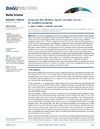Identificador persistente para citar o vincular este elemento:
https://accedacris.ulpgc.es/jspui/handle/10553/21152
| Campo DC | Valor | idioma |
|---|---|---|
| dc.contributor.author | Cabrera, F. | en_US |
| dc.contributor.author | Molina Padrón, Nicolás | en_US |
| dc.contributor.author | Tichavska, M. | en_US |
| dc.contributor.author | Araña, V. | en_US |
| dc.contributor.other | Arana, Victor | - |
| dc.contributor.other | Cabrera-Almeida, Francisco | - |
| dc.date.accessioned | 2017-03-29T02:31:09Z | - |
| dc.date.accessioned | 2018-03-16T09:14:13Z | - |
| dc.date.available | 2017-03-29T02:31:09Z | - |
| dc.date.available | 2018-03-16T09:14:13Z | - |
| dc.date.issued | 2016 | en_US |
| dc.identifier.issn | 0048-6604 | en_US |
| dc.identifier.uri | https://accedacris.ulpgc.es/handle/10553/21152 | - |
| dc.description.abstract | The Automatic Identification System (AIS) standard is encompassed within the Global Maritime Distress and Safety System (GMDSS), in force since 1999. The GMDSS is a set of procedures, equipment, and communication protocols designed with the aim of increasing the safety of sea crossings, facilitating navigation, and the rescue of vessels in danger. The use of this system not only is increasingly attractive to security issues but also potentially creates intelligence products throughout the added‐value information that this network can transmit from ships on real time (identification, position, course, speed, dimensions, flag, among others). Within the marine electronics market, commercial receivers implement this standard and allow users to access vessel‐broadcasted information if in the range of coverage. In addition to satellite services, users may request actionable information from private or public AIS terrestrial networks where real‐time feed or historical data can be accessed from its nodes. This paper describes the configuration of an AIS receiver based on a modular design. This modular design facilitates the evaluation of specific modules and also a better understanding of the standard and the possibility of changing hardware modules to improve the performance of the prototype. Thus, the aim of this paper is to describe the system's specifications, its main hardware components, and to present educational didactics on the setup and use of a modular and terrestrial AIS receiver. The latter is for academic purposes and in undergraduate studies such as electrical engineering, telecommunications, and maritime studies. | en_US |
| dc.format | application/pdf | es |
| dc.language | eng | en_US |
| dc.relation.ispartof | Radio Science | en_US |
| dc.rights | by-nc-nd | es |
| dc.source | Radio Science [ISSN 0048-6604], v. 51 (7), p. 1038-1047 | en_US |
| dc.subject | 330711 Receptores de radio | en_US |
| dc.subject | 332505 Radiocomunicaciones | en_US |
| dc.subject | 120318 Sistemas de información, diseño componentes | en_US |
| dc.subject.other | Automatic Identification System | en_US |
| dc.subject.other | AIS | en_US |
| dc.subject.other | Maritime Surveillance | en_US |
| dc.subject.other | Modular Receiver | en_US |
| dc.subject.other | Ship Detection | en_US |
| dc.title | Automatic identification system modular receiver for academic purposes | en_US |
| dc.type | info:eu-repo/semantics/Article | en_US |
| dc.type | Article | en_US |
| dc.identifier.doi | 10.1002/2015RS005895 | |
| dc.identifier.scopus | 84978522746 | - |
| dc.identifier.isi | 000382991200014 | - |
| dcterms.isPartOf | Radio Science | |
| dcterms.source | Radio Science[ISSN 0048-6604],v. 51 (7), p. 1038-1047 | |
| dc.contributor.authorscopusid | 36760361900 | - |
| dc.contributor.authorscopusid | 57150704700 | - |
| dc.contributor.authorscopusid | 56708893100 | - |
| dc.contributor.authorscopusid | 55368600600 | - |
| dc.identifier.crisid | 2563;48317;-;2406 | - |
| dc.description.lastpage | 1047 | - |
| dc.description.firstpage | 1038 | - |
| dc.relation.volume | 51 | - |
| dc.investigacion | Ingeniería y Arquitectura | en_US |
| dc.rights.accessrights | Acceso libre | es |
| dc.type2 | Artículo | en_US |
| dc.identifier.wos | WOS:000382991200014 | - |
| dc.contributor.daisngid | 3824145 | - |
| dc.contributor.daisngid | 7814937 | - |
| dc.contributor.daisngid | 6358287 | - |
| dc.contributor.daisngid | 2694423 | - |
| dc.identifier.investigatorRID | L-7269-2014 | - |
| dc.identifier.investigatorRID | D-7016-2012 | - |
| dc.contributor.wosstandard | WOS:Cabrera, F | |
| dc.contributor.wosstandard | WOS:Molina, N | |
| dc.contributor.wosstandard | WOS:Tichavska, M | |
| dc.contributor.wosstandard | WOS:Arana, V | |
| dc.date.coverdate | Julio 2016 | |
| dc.identifier.ulpgc | Sí | es |
| dc.description.sjr | 0,545 | |
| dc.description.jcr | 1,581 | |
| dc.description.sjrq | Q1 | |
| dc.description.jcrq | Q3 | |
| dc.description.scie | SCIE | |
| item.fulltext | Con texto completo | - |
| item.grantfulltext | open | - |
| crisitem.author.dept | GIR IDeTIC: División de Ingeniería de Comunicaciones | - |
| crisitem.author.dept | IU para el Desarrollo Tecnológico y la Innovación | - |
| crisitem.author.dept | Departamento de Señales y Comunicaciones | - |
| crisitem.author.dept | GIR IDeTIC: División de Ingeniería de Comunicaciones | - |
| crisitem.author.dept | IU para el Desarrollo Tecnológico y la Innovación | - |
| crisitem.author.dept | Departamento de Señales y Comunicaciones | - |
| crisitem.author.orcid | 0000-0003-1869-1164 | - |
| crisitem.author.orcid | 0000-0002-8220-9806 | - |
| crisitem.author.orcid | 0000-0002-5919-9224 | - |
| crisitem.author.parentorg | IU para el Desarrollo Tecnológico y la Innovación | - |
| crisitem.author.parentorg | IU para el Desarrollo Tecnológico y la Innovación | - |
| crisitem.author.fullName | Cabrera Almeida, Francisco José | - |
| crisitem.author.fullName | Tichavska, Miluse | - |
| crisitem.author.fullName | Araña Pulido, Víctor Alexis | - |
| Colección: | Artículos | |
Citas SCOPUSTM
9
actualizado el 08-jun-2025
Citas de WEB OF SCIENCETM
Citations
8
actualizado el 08-jun-2025
Visitas
95
actualizado el 23-ene-2024
Descargas
652
actualizado el 23-ene-2024
Google ScholarTM
Verifica
Altmetric
Comparte
Exporta metadatos
Los elementos en ULPGC accedaCRIS están protegidos por derechos de autor con todos los derechos reservados, a menos que se indique lo contrario.
